Standing on Rhodes’ ancient cobblestones with Mediterranean waves crashing nearby, I finally got it—this Greek island just grabs you. Rhodes blends medieval history and jaw-dropping beaches, so you get both a cultural treasure and a sun-drenched paradise in the Dodecanese.
It’s the fourth largest Greek island, and people call it the “Island of the Knights” because the medieval Knights of St. John ruled here from 1309 to 1522.
My first look at the UNESCO World Heritage medieval city honestly left me speechless. Massive stone walls and winding streets made me feel like I’d stumbled into a living history book.
But Rhodes isn’t just about the past. Ancient ruins hint at Greek gods, while golden beaches practically beg you to drop your towel and relax after a day of exploring.
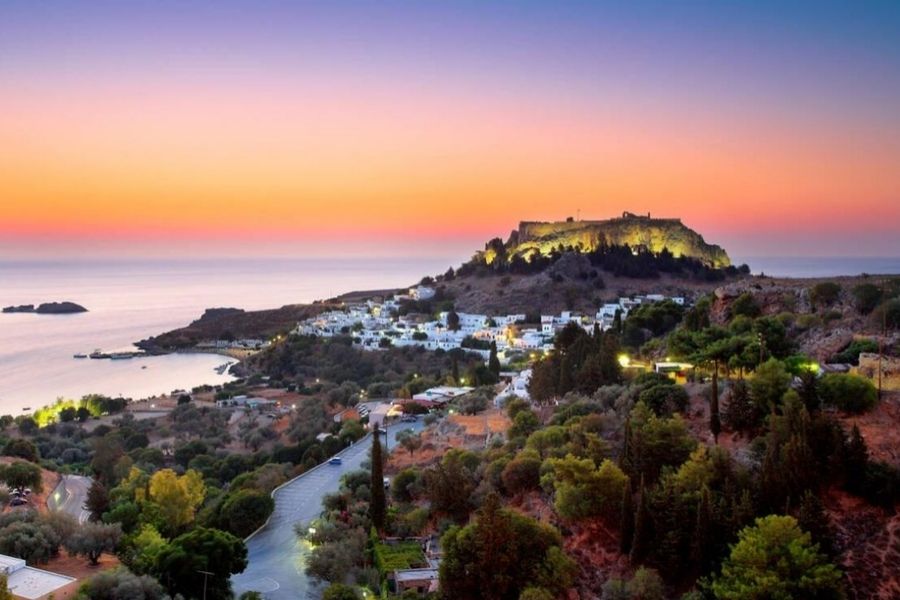
You’ll find legendary dragon tales at Mount St. Stephen, and then, just a short drive away, beaches that could compete with any in the Mediterranean. Rhodes serves up surprises, and I never expected to find this much variety on one island.
The best part? Mornings are for medieval tours, and afternoons are for the beach. It’s the kind of Greek island adventure that keeps both history buffs and sun-seekers happy.
Knights, Legends, and the Medieval City
The Knights of St. John turned Rhodes into Europe’s most impressive medieval fortress city between 1309 and 1522. Their legacy still lives on—just look at those cobblestone streets and the world’s oldest inhabited medieval town.
Knights of St. John: Guardians of Rhodes
In 1309, the Knights of Saint John arrived in Rhodes after losing their stronghold in the Holy Land. Their journey from hospital caregivers to military rulers? Fascinating.
These medieval warriors made Rhodes their own sovereign state for over two centuries. They even minted their own coins and built a commercial port that rivaled Venice.
During their rule, they:
- Built massive fortification walls
- Set up a thriving hospital system
- Created a gateway between Europe and the Holy Land
- Developed military architecture that was ahead of its time
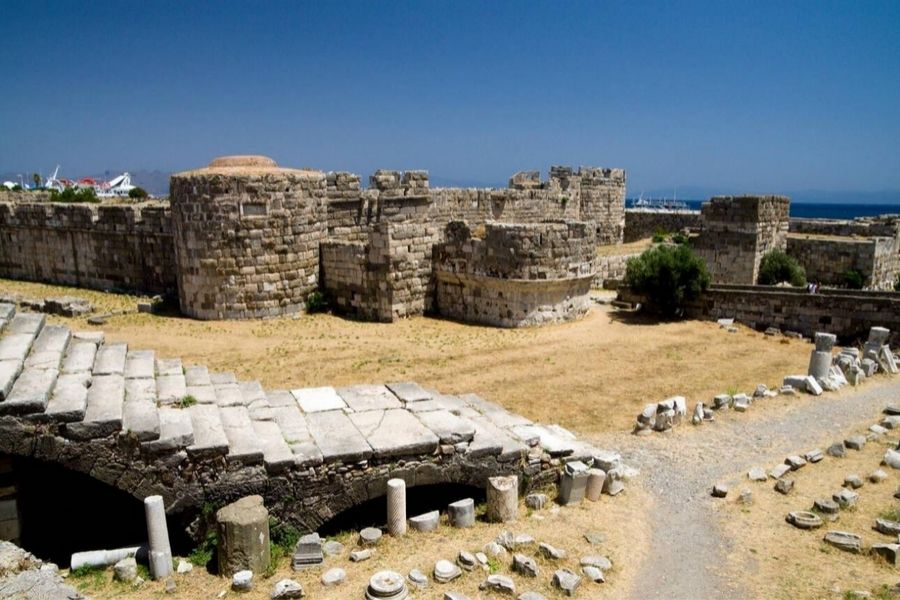
The Knights organized themselves into “tongues” by nationality, and each group defended a different section of the city walls.
They didn’t just follow old blueprints; they adapted their fortress designs to handle gunpowder weapons. It’s no wonder Rhodes was almost impossible to conquer.
The Order’s mission combined healing and warfare, and you can see that in every structure they left behind. Each building had a practical use but also made a statement about their faith.
Medieval City of Rhodes: UNESCO Heritage and Living History
Rhodes Old Town stands as Europe’s oldest inhabited medieval city. UNESCO gave it World Heritage status, and after walking these streets, I get it.
The city walls stretch for 4 kilometers, dotted with towers and gates. These fortifications are medieval military engineering at its best.
Inside those walls, about 6,000 people still live and work. That’s what makes Rhodes different—it’s not just a preserved site, but a living, breathing community.
What makes the medieval city so special?
- People have lived here for over 700 years, nonstop
- Best-preserved medieval fortifications in Europe
- A mix of Gothic, Byzantine, and Islamic architecture
- A real local community, not just tourists
Narrow cobblestone streets twist between ancient buildings. Each turn brings another piece of history from the Knights’ era.
It amazes me how the old city layout still works. Fourteenth-century city planning still shapes daily life here.
Palace of the Grand Master: Fortress of Power
The Palace of the Grand Master dominates Rhodes town from its highest point. This huge fortress served as both home and headquarters for the Knights’ leader.
They built it on top of an ancient temple, mixing Gothic and Byzantine styles. Thick walls and defensive towers hint at the threats the Knights faced.
Inside, you’ll find grand halls with intricate mosaics and frescoes. The palace wasn’t just about defense—it also showed off the Order’s wealth and culture.
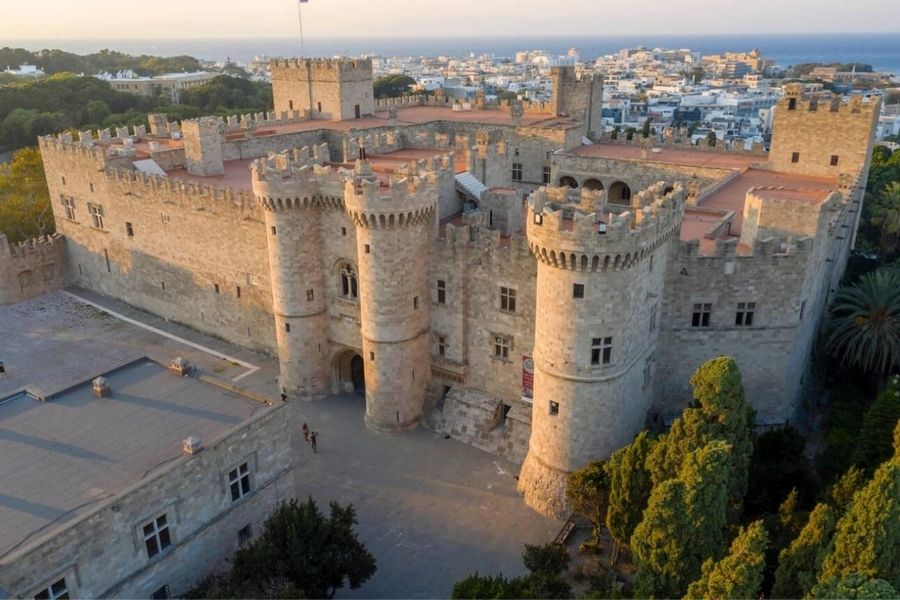
Palace highlights I’d recommend:
- The Great Hall with its amazing ceiling
- Ancient mosaic floors from Kos
- Medieval furniture and artifacts
- Panoramic tower views
The Knights made their biggest decisions here. Every major move in Rhodes and the eastern Mediterranean started within these walls.
The palace today is partly reconstructed, but you still feel the power the Grand Masters held. Standing in the courtyard, I could almost see the Knights readying for their final siege.
Street of the Knights and Hippocrates Square
The Street of the Knights stands as medieval Europe’s best-preserved knights’ quarter. Each building belonged to Knights from different countries, creating a unique international vibe.
Walking this cobblestone street feels like time travel. Those Gothic facades and carved doorways? They look just as they did five centuries ago.
Each “Inn” belonged to a different tongue—England, France, Spain, Italy, Germany, Aragon, and Provence. The Knights lived, ate, and planned in these halls.
Along the street, check out:
- The Inn of France with its elaborate details
- The Inn of Spain, known for its stonework
- Original medieval paving stones
- Authentic Gothic windows and doors
Hippocrates Square connects the medieval city to modern Rhodes town. This lively plaza sits right at the old city’s entrance.
The medieval fountain and surrounding buildings make for perfect photos. I love how this spot bridges seven centuries of city life.
From here, you can set out to explore the whole medieval quarter. It’s the ideal starting point for discovering what the Knights left behind.
Ancient Myths and Marvels
Rhodes comes straight out of Greek mythology. Zeus promised new land to the forgotten sun god Helios, and the legendary Colossus of Rhodes became one of the Seven Wonders that inspired monuments like the Statue of Liberty.
Zeus, Helios, and the Birth of Rhodes
The story of Rhodes starts with a divine mistake. When Zeus divided the lands among the gods after defeating the Titans, he forgot about Helios, who was away at the time.
Helios came back and demanded his share. Zeus promised him the next land to rise from the sea.
Right then, Rhodes emerged from the Aegean—green and beautiful. Helios blessed the island with endless sunshine, earning it the nickname “Island of the Sun.”
The sun god fell for Rhode, a sea nymph and Poseidon’s daughter. They became the island’s guardian deities, and Helios named Rhodes after her.

Their seven sons, the Heliadae, inherited the island. Three grandsons—Kameiros, Ialysos, and Lindos—split Rhodes among themselves. Each built cities that bear their names, and their ruins are still around to explore.
Colossus of Rhodes: Echoes of a Wonder
No Rhodes legend is bigger than the Colossus. This massive bronze statue of Helios once guarded Mandraki Harbour and was one of the Seven Wonders of the Ancient World.
Rhodians built it to celebrate victory over Demetrios, a successor of Alexander the Great who besieged the island in 305 BC. Sculptor Chares of Lindos completed the statue between 292–280 BC.
The Colossus stood for only 54 years before an earthquake toppled it in 226 BC. Even in ruins, it amazed visitors for generations.
Muslim forces later hauled away the remains in 693 AD. According to records, it took 900 camels to carry off the melted bronze.
Today, bronze deer statues mark the supposed spot at Mandraki Harbour, though experts still debate if the Colossus actually stood astride the entrance.
Statue of Liberty: A Modern Connection
The Colossus of Rhodes inspired America’s most iconic monument. French sculptor Frédéric Auguste Bartholdi studied ancient accounts of the Colossus while designing the Statue of Liberty.
Both statues share some serious similarities: towering height, symbolic meaning, and harbor locations that greet arriving ships. The Statue of Liberty is, in a way, a modern Colossus, welcoming people to New York Harbor.
Bartholdi even called his creation a “new wonder of the world.” The link between Rhodes and America goes deeper than most people realize.

That torch-bearing pose? It ties both statues to solar deities, carrying Helios’s legacy from ancient Greece all the way to modern America.
Dodecanese Jewel: Geography, Towns, and Landmarks
Rhodes sits at the heart of the Dodecanese, where medieval walls meet bright blue Mediterranean waters. The island’s location shaped everything, from its busy harbor town to ancient ruins perched on hills.
Rhodes Town: North, New Town, and Mandraki Harbor
The City of Rhodes stretches across the island’s northern tip, and honestly, I’m still amazed by how the old and new blend together. Rhodes Town splits into distinct areas, each with its own vibe.
The medieval Old Town sits inside massive stone walls. I lost track of time wandering its cobbled streets, imagining the Knights of St. John passing by.
The New Town spreads outside the old walls, offering modern hotels, restaurants, and shops along leafy boulevards.
Mandraki Harbor is the town’s lively center. Three windmills guard the harbor entrance, and legend says the Colossus once stood here. I watched fishing boats and yachts sharing waters that have welcomed sailors for over 2,000 years.
The harbor buzzes from sunrise to midnight. Waterfront cafes serve fresh seafood, and tour boats head out to beaches and nearby islands.
Dodecanese Islands and the Mediterranean Setting
Rhodes anchors the Dodecanese Islands, a group of 12 main islands scattered across the southeastern Aegean Sea. This Greek island sits just 11 miles from the Turkish coast, putting it at the crossroads of Europe and Asia.
The Mediterranean climate here is no joke—over 300 days of sunshine a year. I’ve visited in spring and fall, and the weather was perfect. Summers are warm and dry, winters are mild, and frost is rare.
The island stretches about 50 miles long and 23 miles wide, making it the biggest in the Dodecanese. Mountains climb up to 3,986 feet at Mount Attavyros, so the landscape shifts from pine forests to olive groves to beaches.

Rhodes’ location made it a trading hub for centuries. Ships moving between the Black Sea and Egypt always stopped here for supplies and shelter.
Acropolis of Rhodes: Glimpses of Antiquity
The Acropolis of Rhodes sits atop Monte Smith hill, offering sweeping views over Rhodes Town and the Mediterranean. Unlike Athens’ acropolis, this ancient site is spread out across a wooded hillside.
I climbed up to the restored stadium where ancient athletes once competed. The marble seats still shine in the afternoon sun.
Nearby, the Temple of Apollo Pythios stands partly rebuilt, its columns framing views toward the Turkish coast. The ancient theater, carved out of the hill, seats 800. I couldn’t help but imagine the plays and comedies that once filled those stone seats.
Archaeologists say this site was sacred to Apollo as far back as the 3rd century BC.
Walking trails connect the scattered ruins through pine groves that smell amazing. Info panels explain how this hilltop complex was the religious and cultural heart of ancient Rhodes.
Lindos: Ancient Splendor and Seaside Charm
Lindos stands out as Rhodes’ most captivating ancient town. Whitewashed Cycladic houses spill down hillsides below a towering acropolis, blending 4th-century temples with medieval walls and dreamy beaches.
Village Life and Cycladic Atmosphere
Lindos’ narrow cobblestone streets wind between traditional whitewashed homes. The buildings follow Cycladic style—clean lines, bright white walls, and a sun-drenched look.
Many of these are actually captain’s mansions. Back in Ottoman times, wealthy sea captains built these homes, and their fancy doorways and courtyards hint at a rich maritime past.
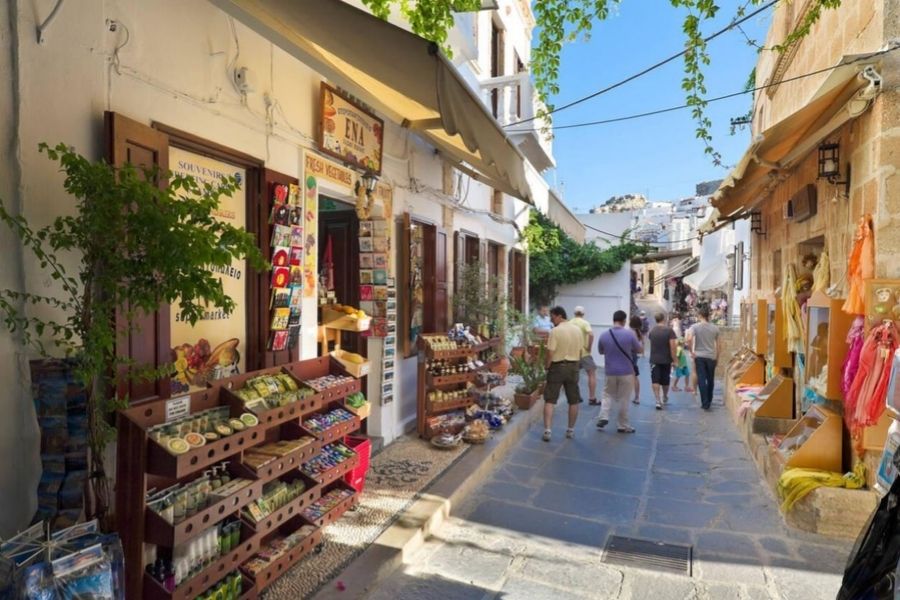
Key features you’ll spot:
- Pebble mosaic courtyards
- Carved stone doorframes
- Flat rooftops
- Narrow alleys that stay cool and shady
The village center is car-free, which keeps its authentic vibe. Donkeys still haul goods up steep paths to the acropolis.
Local shops sell ceramics and textiles in classic designs. Small tavernas serve up seafood straight from local fishermen.
Even with all the tourists, Lindos keeps a relaxed feel. I’ve found that early mornings are the best time to wander—before the crowds show up.
Acropolis of Lindos: Timeless Views
The Acropolis of Lindos rises 116 meters above sea level on a dramatic cliff. Ancient ruins here tell stories from more than 2,500 years ago.
Major monuments include:
- Temple of Athena Lindia (4th century BC)
- Hellenistic Stoa colonnade
- Byzantine Church of St. John
- Medieval castle walls
- Ancient theater remains
The Temple of Athena Lindia once drew crowds from all over Greece. People came to honor the goddess of wisdom and warfare here.
In the 14th century, the Knights of St. John built fortification walls. These thick defenses now blend almost perfectly with the ancient Greek stones.
I huffed my way up the steep stone steps and, wow, those panoramic views of the Aegean Sea are something else. You can see across glittering bays and spot distant islands—honestly, it’s a photographer’s dream up there.
St. Paul’s Bay and Local Legends
St. Paul’s Bay curves below the acropolis in a perfect horseshoe. The beach here is small, sandy, and the water sparkles turquoise, always calm thanks to the sheltering cliffs.
Legend says the Apostle Paul landed here in 51 AD, spreading Christianity to Rhodes. There’s a tiny white chapel by the water where locals say he first stepped ashore.
Swimmers love the bay’s gentle, clear waters. It’s a great spot for families, and the beach tavernas serve up fresh fish and icy drinks.
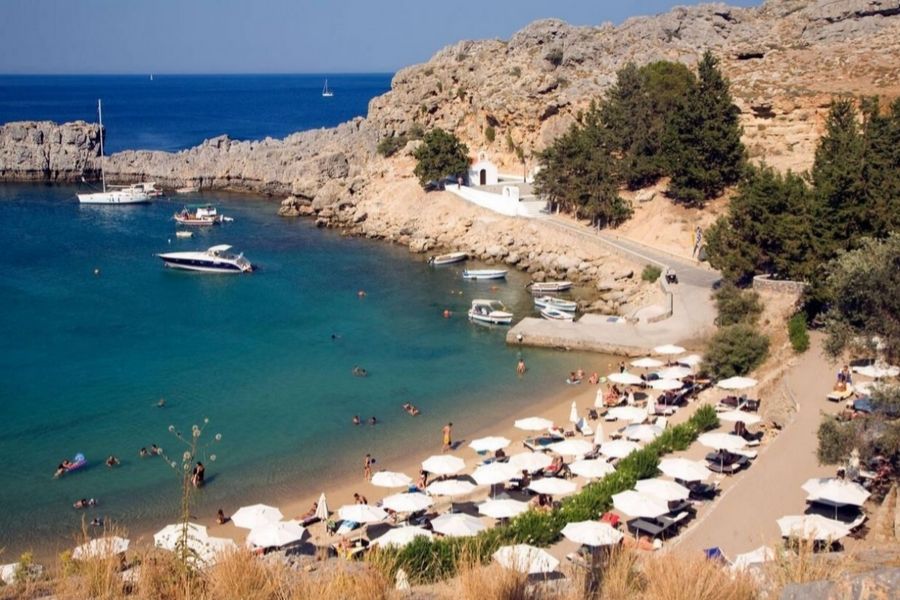
Bay highlights:
- Shallow, warm waters
- Fine golden sand
- Dramatic cliff backdrop
- Historic chapel
- Snorkeling opportunities
I noticed the bay stays quieter than Lindos’ main beach. It’s just a 10-minute walk from the village, though the rocky path can be a bit tricky. Floating here feels like drifting in a natural amphitheater, surrounded by cliffs and history.
Sun-Drenched Beaches and Natural Wonders
Rhodes has over 40 beaches waiting to be discovered, from bustling Blue Flag stretches to hidden coves perfect for snorkeling. The island hides natural gems like thermal springs with healing waters and unique ecosystems that draw thousands of butterflies every summer.
Best Beaches on Rhodes
Lindos Beach stretches out below the ancient acropolis, all soft yellow sand and shallow water. Megali Paralia, the main part, is ideal for families with little kids.
Anthony Quinn Bay got its name after the 1960s film “The Guns of Navarone.” This tiny cove has crystal-clear waters that are just right for snorkeling and diving.
St. Paul’s Bay lies close to Lindos and forms a protected horseshoe. The golden sand and calm water make it a peaceful spot.
Tsampika Beach runs for almost two miles, offering fine sand and emerald waters. Water sports fans and sun-seekers flock here for the bars and activities.
Afandou Beach boasts Blue Flag status and a long stretch of sand and pebbles. It’s less crowded, making it a favorite for those who want more space.
| Beach | Best For | Key Features |
|---|---|---|
| Lindos | Families | Shallow water, facilities |
| Anthony Quinn | Snorkeling | Clear water, scenic |
| St. Paul’s Bay | Photography | Protected cove, golden sand |
| Tsampika | Water sports | Long stretch, amenities |
| Afandou | Space | Blue Flag, less crowded |
Kallithea Springs and Ladiko Bay
Kallithea Springs stands out with restored 1920s domes and intricate mosaics. People once flocked here for the healing thermal waters.
The rocky beach area invites swimmers for a unique dip. Sunlight bounces off the white stone platforms and the water looks impossibly blue.
Ladiko Bay sits just a few minutes from Anthony Quinn Bay. This smaller beach offers quiet and the same stunning water clarity.
Several small coves connect by footpaths, each with their own angle on the coastline and pine forests. You can find a new view around every bend.

Beach bars here serve up fresh seafood and local dishes. The blend of history and natural beauty makes this whole area feel special.
Valley of the Butterflies and Prasonisi
Valley of the Butterflies (Petaloudes) bursts into life from June to September. Thousands of Jersey Tiger moths cover tree trunks and rocks, turning the shaded valley into a living mosaic.
A wooden walkway leads visitors along a stream through the reserve. The cool, damp air feels like a different world compared to Rhodes’ sunny coast.
Prasonisi stands out as one of Rhodes’ wildest natural sights. A sandy strip links the main island to a little islet at the southern tip.
Windsurfers and kitesurfers chase the strong breezes here. The beach splits into two sides—one calm, one with rolling waves, all depending on the wind.
Sometimes, winter storms swallow the sandy link, making Prasonisi a true island for a while. Eventually, the waters pull back and reconnect it.
The area falls under Natura 2000 protection. Native plants and migrating birds rely on this unique ecosystem all year round.
Frequently Asked Questions
Rhodes mixes medieval wonders like the Palace of the Grand Masters with dreamy beaches such as Faliraki and Tsambika. The island makes travel easy with family activities, lively nightlife, and simple transport by bus or rental car.
If you love medieval history, you can’t miss the Palace of the Grand Masters. This imposing fortress once served as headquarters for the Knights of St. John.
The Street of the Knights lets you wander through perfectly preserved medieval architecture. I strolled these cobbled lanes, imagining knights in armor going about their day.
The Archaeological Museum displays medieval treasures in a former knights’ hospital. You’ll spot weapons, armor, and daily items that bring history to life.
Massive stone fortifications wrap around Rhodes Old Town. These defensive walls once protected the city from Ottoman sieges.
Inside the city, the Church of Our Lady of the Castle holds beautiful medieval religious art. The knights built this sacred place for their community.
Faliraki Beach gives couples a mix of relaxation and lively beach bars. There’s plenty of space for sunbathing or trying water sports.
Tsambika Beach offers golden sand and clear water in a quieter setting. The drive down is a bit of an adventure, but the views are absolutely worth it.
Anthony Quinn Bay tempts snorkelers with emerald water and dramatic rocks. It’s smaller and feels more private than many other beaches.
Lindos Beach combines swimming with ancient history. You can wander the Acropolis and then cool off in the sea below.
Prasonisi Beach calls to windsurfers and adventure seekers. The unique landscape links the island to a sandy peninsula.
Rhodes Town surprises with its variety—rooftop bars, beach clubs, and everything in between. The medieval backdrop adds a bit of magic to nights out.
Faliraki draws party-lovers with an endless supply of clubs and bars. The energy here runs late into the night, especially in summer.
The Old Town charms with romantic wine bars and cozy tavernas. Couples can soak up live music and a more authentic vibe.
Ixia and Ialyssos line their beaches with relaxed bars, perfect for sunset cocktails. It’s a welcome change from Faliraki’s wild side.
Casino Rodos shakes things up with gaming and a different kind of evening fun. Sometimes you just want to try your luck, right?
Butterfly Valley feels like a fairy tale for kids and adults. In summer, thousands of butterflies flutter through this peaceful haven.
Rhodes Aquarium brings the Mediterranean’s sea life up close. Kids can peer at sharks, sea turtles, and all sorts of colorful fish.
Families can join treasure hunts in the medieval town. Children solve puzzles as they explore winding alleys and ancient buildings.
Faliraki Water Park packs in water slides and pools for every age. Honestly, it’s easy to spend the whole day here.
Ostrich Farm and Zoo near Faliraki lets kids meet ostriches, emus, and other animals. It’s a quirky stop that always gets smiles.
tart your walk at the Marine Gate—just stepping through sets the tone for adventure. The original entrance feels like a portal to another era.
Head straight for the Palace of the Grand Masters. I’d suggest spending about 90 minutes exploring before the crowds build up.
Next, stroll down the Street of the Knights toward the harbor. The stone lodges and old architecture tell their own stories.
Pop into the Archaeological Museum in the old Knights’ Hospital. The building alone is worth a look, with its grand medieval halls.
Finish your tour at the Clock Tower for sweeping views over the rooftops and harbor. Climb the steps, snap some photos, and take it all in.
Plan on about 4-5 hours for this route, including museum stops. Wear comfy shoes for those cobblestones—and don’t forget a bottle of water.
Honestly, if you want the most freedom, renting a car is the way to go. You’ll find it much easier to reach those quiet beaches and tucked-away villages that buses just don’t get to.
I’d suggest you book your car rental ahead of time, especially in the summer. The prices and options get a lot better if you plan a little in advance.
Buses can actually be a solid option too, at least if you’re sticking to the main towns or popular beaches. During the tourist season, the public buses run pretty reliably.
Rhodes Town has a main bus station. From there, you can catch rides to spots like Lindos, Faliraki, and a bunch of other destinations.
If you’re only going a short distance, taxis can do the trick. They’re great for airport transfers or heading out in town at night, but honestly, they get pricey if you want to explore all day.
Some folks love renting scooters for zipping between beaches. If you go that route, double-check your insurance and definitely wear a helmet—those roads can get hectic.
And then there’s always walking, especially in Rhodes Old Town. The medieval sights are close together, so you can just wander and soak it all in without worrying about transport.

